Missionary position
Poverty, illness, disasters - Mother Teresa showed up at all more or less significant events. She whispered words of consolation, spoon-fed her, and called on her to pray. But there was no real help.
Teresa's Homes for the Dying, Mary Loudon
compared to Nazi concentration camps.
“Folding beds, mattresses on the floor or hammocks in which the sick lie mixed together,” Mary described the situation. — All of them have their heads shaved (for Indian women this is akin to shame), many are tied up. Suffering is “eased” with aspirin. Needles from syringes and droppers are washed in cold water and reused. Many could have been saved by sending them to the hospital or simply injecting them with antibiotics, but this was not done.
Saint Teresa and Princess DIANA agreed on divorce: when you really want it, you can
Mary’s words were confirmed by the same volunteers from the shelters of the Order of the Sisters of the Missionaries of Love. Medical professionals were not accepted into Mother Teresa's institutions. Those who visited there for inspection were horrified by the unsanitary conditions, but their indignant voice was drowned in a sea of laudatory speeches addressed to the “holy woman.”
“There is something beautiful in the way the poor accept their lot, the way they suffer like Jesus on the cross,” Teresa admonished, prohibiting pain relief.
The main task of the staff was to persuade the patients to accept the Catholic faith. The dying were baptized without asking: a wet rag on the forehead, prayer - that’s it, he’s a Catholic.

Exhorting the suffering, Teresa inspired them: “You suffer like Christ on the cross. Jesus must kiss you." One day someone objected to her: “So tell him to stop kissing me.” The kind grandmother left the remark unanswered
Harsh conditions of rescue
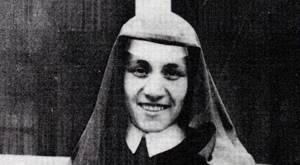
We know that Mother Teresa had shelters in which sick people were treated. But was it true that they treated people there and did not cripple their personality? The “holy” woman was a complete supporter of Catholicism, so she inclined everyone she met along the path of life to it.
This happened to the unfortunate people who ended up in her hospitals. There they were greeted by disgusting conditions, complete unsanitary conditions and a disregardful attitude. They slept either on the floor or on dilapidated cots, and their pain was relieved with aspirin.
There was no talk of any treatment. Witnesses said that even the instruments there were simply rinsed with cold water and “visited” to the next patient. The main condition for staying there and being given some painkillers was consent to accept a faith similar to Teresa.
Help is not for everyone
— On July 26, 1963, an earthquake occurred in Skopje. More than a thousand people died, three-quarters of the buildings were destroyed. Mother Teresa blessed the employees of the American military hospital who were leaving for the capital of Macedonia, but did not allocate a penny from her fund to her hometown. The Americans stayed in the destroyed Skopje for 15 days. Ten of them went into setting up and dismantling the hospital. Five are at a photo shoot. By the way, 500 Soviet military engineers then worked in Macedonia for six months.
“Mother Teresa assured that her organization feeds more than a thousand people in Calcutta every day. According to Arup Chatterjee
- a doctor who investigated the activities of Mother Teresa, there were only three soup kitchens, and they could feed a maximum of one hundred people. Moreover, gruel was given only to those who had food cards. It was impossible for non-Christians to receive them. The “saint” also lied about the number of schools for five thousand poor children - there was only one for a hundred children. And that volunteers pick up the weak on the streets and take them to shelters. In fact, no one was picked up, and the ambulances donated to the order were used to transport the nuns. They say that documents were also discovered about the sale of children from the orphanage, but the matter was quickly hushed up.
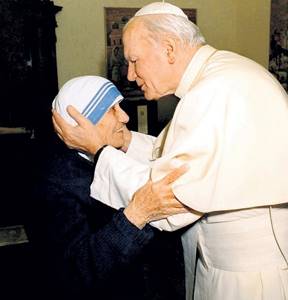
- In 1984, a vat of toxic substances with a volume of 60 thousand liters exploded at an American chemical plant located in the Indian city of Bhopal. 4 thousand people died immediately, 21 thousand died within a few days. Almost 600 thousand were injured - a disaster comparable to Chernobyl. Mother Teresa urgently came to the city and explained to the residents: this is God’s punishment, so they need to humble themselves and pray. She managed to stop the protests after a few years and paid the victims and relatives of the victims almost half a billion dollars. Not a single American employee was responsible for the accident - seven locals were imprisoned. And Mother Teresa’s foundation received a tidy sum into the account.
By the way, Mother Teresa’s visit to the Armenian Spitak after the 1988 earthquake was widely covered in the press. But there is no mention that the victims were helped financially.
And further. In 1993, an earthquake in the Indian province of Latur claimed the lives of 8 thousand people. Five million ended up on the street. Other organizations built houses for them, but Mother Teresa posed in front of them, not sending a penny to the victims.
Big life
- August 26, 1910, Skopje. into the wealthy Albanian Catholic family of Bojaxhiu
-
Agnes Godje
. - 1919 The head of the family, Nikola Bojaxhiu
, a nationalist who advocated the cleansing of Skopje from the Slavs, that is, Serbs, Macedonians and Bulgarians, and the annexation of the city to Albania, was killed. - 1928 Agnes graduated from a Serbian gymnasium and went to Ireland, where she entered the monastic order of the Sisters of Loreto. She will never speak her native language again; when visiting Yugoslavia, she will begin to communicate through an interpreter.
- 1931 The girl takes monastic vows and takes the name Teresa. She is sent to Calcutta to teach at St. Mary's Girls' School.
- 1946 Jesus Christ
allegedly appears to Teresa . He tells her to quit school, wear a sari and go help the poor. However, Mother Teresa was confused many times in her “testimonies”: she said, for example, that God regularly appeared to her from the age of five. - 1948 The authorities of Calcutta give Teresa the former temple of the goddess Kali. From now on there will be a House for the Dying. The staff is recruited from the order founded by the nun, the Missionary Sisters of Love.
- 1969 The BBC is making a documentary about Mother Teresa. PR will do its job: churches of the order will be organized in 121 countries of the world, the number of nuns will increase to 5 thousand, volunteers - to 40 thousand. Teresa will be perceived as a saint.
- 1979 Mother Teresa is awarded the Nobel Peace Prize “for her work in helping suffering people.”
- 1997 On March 13, Mother Teresa resigned from her duties as head of the Order of Mercy. She died on September 5. Almost immediately, the Catholic Church began the process of beatification, followed by canonization. Although, according to the rules, this procedure can be started no earlier than five years from the date of death.
- 2016 In St. Peter's Square in Rome, in the presence of 120 thousand people, including 1.5 thousand Italian homeless people, Pope Francis canonized
Mother Teresa.
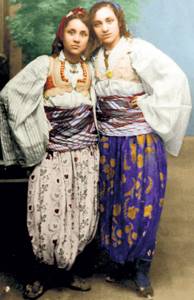
Worldwide fame brought money. But the origin of the specie was of little interest to the benefactor.
- $1.5 million was given to Teresa by Jean-Claude Duvalier
, the President of Haiti, the dictator.
“Nowhere have I seen such closeness between the poor and the head of state,” Mother Teresa said hypocritically, as if not noticing poverty and disease in one of the poorest countries in the world. Her arrival cost the authorities $1 million.
- The order's account was replenished after Teresa's visit to Albania. She had a nice conversation with the leader of the country, communist Ramiz Alia
, and then laid a wreath on the grave of his predecessor
Enver Hoxha
, who closed all churches, executed or imprisoned clergy. - British media tycoon Robert Maxwell
stole $600 million from his employees' pension fund and sent part of it to Mother Teresa. - American businessman Charles Keating
, who also embezzled the money of fund investors, pinched off the “saint” $1.25 of his $252 million.
When he was imprisoned, Teresa asked for leniency. Prosecutor Paul Turley
suggested she return the stolen money to its owners. At this point the correspondence ended. - Having made friends with Indira Gandhi
, Teresa got her monastic order to be exempted from inspections. She advised journalists who asked awkward questions about spending money to talk to God. Shortly before her death, documents surfaced showing that about seven percent of donations went to charity. The rest, including Teresa's Nobel Prize, was sent to the Vatican Bank in Rome and spent on the needs of the Catholic Church.
Generally against it, but sometimes for it
Mother Teresa, as befits a Catholic, opposed abortion and divorce. But when it came to people with whom she was friends and from whom she could get a jackpot, her position changed. She supported Indira Gandhi in forcibly sterilizing the poor and called Princess Diana's
about divorce from
Charles
is the only right thing, since love has left the family.
Teresa also demanded that contraception be banned. I did not accept the argument that they protect not only from conception, but also from certain diseases.
“AIDS is a fair retribution for improper sexual behavior,” she argued.
I didn’t deny myself anything
Mother Teresa preferred to travel around the world on private jets or first class. Moreover, the airlines themselves often paid for her flight.
Teresa did not want to solve health problems in her centers, preferring clinics in the USA, Italy and India. She stated that she could not afford cataract surgery for $6.5 thousand at the St. Frances Clinic in Pittsburgh, and a year later she had the operation at the New York Medical Center - even more expensive. During heart surgery, Teresa never refused pain medication in order to suffer like Jesus. She spent the last months of her life in a room stuffed with modern equipment.
Miracles in a sieve
The Catholic Church can canonize a person if he has performed a miracle. At first, they tried to declare the disappearance of a malignant 17-centimeter tumor in the stomach of the Indian woman Monica Besra.
Allegedly, on the anniversary of Mother Teresa’s death, the woman’s sister applied a diseased medallion to her stomach, which was used to touch the body of the future saint on the day of the funeral.
She prayed, and soon the tumor resolved. But the husband of the healed woman admitted: his wife did not have cancer, but an ovarian cyst, and the doctors dealt with it. Teresa's declaration of sainthood was postponed. Until Reverend Brian Kolodiychuk
found a new miracle.
Brazilian resident Marcilio Haddata Andrino
suffered from brain cancer. His wife Fernanda prayed to Mother Teresa and everything passed. Doctors were not involved in this story, so it was impossible to confirm or deny it.
Divine Light
BBC journalist Malcolm Muggeridge
who was making a film about Teresa, said: they say, there was no electricity in the House for the Dying, but the filming was a success because divine light appeared.
the words of cameraman Ken McMillan
that this was just a new film for night shooting.
Mother Teresa's Diaries Shatter the Unhealthy Image of Cheerful Charity
Criticism of Blessed Mother Teresa received new impetus after the publication of her diaries. She appeared to the world in weakness, became vulnerable to universal judgment - and the judgment did not slow down. Why did the Catholic Church do this? We offer our readers material prepared by the portal “Miloserdie.ru”.
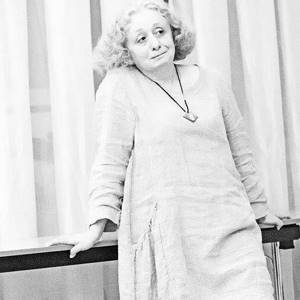
Svetlana Panich , translator of the diaries of Mother Teresa of Calcutta, says
Sugar with pepper
— In the West, Mother Teresa’s diaries were published in 2007, in Russia - in 2010, when the book “Be My Light” in your translation was published. But the criticism of Mother Teresa itself began during her lifetime, long before the publication of the diaries. What did the diaries add to this criticism?
— The peculiarity of this publication is that the texts included in it were in no way intended to be made public. Mother Teresa did not want her correspondence to be known to anyone other than the direct addressees; she repeatedly asked her confessors for their blessing to destroy the letters. Moreover, she kept diaries only for herself and clearly did not intend them as a message to descendants.

However, the postulator of the process of canonization of Mother Teresa, Father Brian Kolodeychuk, decided to partially publish them after Mother Teresa was beatified. The book was distributed throughout the world, shattered many illusions of part of the church public and asked many questions to the secular public. What kind of illusions were these and what kind of questions?
It turned out that M. Teresa, as she revealed herself in her letters and diaries - an incredibly strong personality, very decisive, with a difficult character, often harsh and tough - is completely different from the cheerful, “pink-marzipan” one, as Natalya put it Leonidovna Trauberg, the image of a “cheerful nun”, which was replicated by religious literature and partly, with the best intentions, was picked up by secular publications.
There were even many who, after reading the book, asked: “Does your saint believe in God?”
The problem of the discrepancy between the image of a saint and social expectations or cultural ideas is very interesting. This was the case with mother Maria (Skobtsova); Mother Teresa, during her life and after her death, also became the subject of controversy.
For many people, it is easier to deal with images that are impeccable, “sweet” to the point of cloying, but with “pepper” of ostentatious asceticism, intrusive eccentricity or heroism.
This “pinch of pepper” is present in many biographies of saints - torture of the flesh, the search for suffering, temptations in the spirit of pious nightmares of baroque art, hysterical repentance; stories about M. Teresa are no exception. But as soon as a person, sincerely trying to imitate his beloved saint, begins to follow the “formular” image offered to him, it turns out that this is impossible: attempts to imitate this image turn into religious hysteria.
Faith is not in words, but in deeds
If we look at Mother Teresa’s sisters, we will see very sober, healthy, very mentally stable women. This was the requirement from the very beginning for those who came to the congregation. Sisters, Mother Teresa wrote, should be “strong in body and sound in mind, be generous and love the poor. They need to be ready to take on any job, no matter how dirty it may seem. They must be cheerful and responsive."
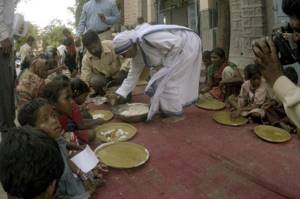
There is no trace of “heavenly sweetness” there. It cannot exist, because, excuse me, in order to wash the homeless, “sweetness” is not needed. It takes different skills, a different heart. You need to understand that you are washing a homeless person, and not “performing a spiritual feat.”
And for this you need an extremely healthy attitude towards yourself.
But it was precisely in the church environment that a persistent idea developed, and from there to the secular one, that everything that Mother Teresa did was born from “bright faith,” or rather, from enthusiastic religiosity. Her private recordings leave no trace of this legend.
It turned out that the “radiant mother”, who asked to “smile at Jesus” more often and called to do all things in joy, lived for more than thirty years in severe abandonment of God. In the first years of her monastic life, M. Teresa experienced a powerful mystical experience, which became the beginning of her path, which was very strange for the Church of that time. Only the survivor has the right to talk about such an experience - all our attempts to choose words here will be at best inaccurate, at worst dishonest.
But then darkness sets in for several decades. And it was during these years that she leaves the prosperous monastery and descends to the very bottom of the social ladder, goes to places of extreme poverty and vice, opens congregational houses in different countries, creates hospitals and hospices for the poor.
And he writes to his confessors: “I don’t know what to do. There is no god. There is no heaven. I know that I am on the road to hell. What should I do if God left me? Then he takes the broom again and goes for revenge.
The question may arise: was this not a kind of therapy, when a person, in order to pull himself out, undertakes to help those who are even worse? There is nothing wrong with such therapy (unless, of course, it is passed off as “selfless service”), but I think Mother Teresa was too simple-minded for it. Rather, and this is clear from private records, this is how she tried to respond to the well-known gospel words, which were perceived with the utmost responsibility as an appeal to her personally: “just as you did it to one of the least of these brothers of mine, you did it to me.”
Thirst for mercy
Another “key” to her actions is, as seriously as a personal request, the heard word of Christ on the Cross: “I thirst.” For her, Christ’s “Thirst” is, first of all, a thirst for mercy. To whom? Yes, all to the same neighbors about whom Christ speaks in the parable of the Last Judgment - the hungry, the poor, the homeless, the sick and dying, outcasts, marginalized people.

This was her “social program”, which she, a strong and purposeful person, tried to implement as soon as possible and at any cost. First of all, at the cost of the incredible internal efforts that were required to, despite the “darkness in the heart,” pick up the sick and homeless on the streets, care for the dying and generously smile at everyone - from the homeless to the “lords of the world.” Sometimes at the cost of one’s own reputation.
Here we inevitably intrude into the area with which most of the rumors and slander about Mother Teresa are associated. We are talking about her moral “omnivorousness” and “dubious connections.”
When in 1948 she achieved canonical permission, without breaking her vows, to live outside the monastery, and settled in one of the poorest areas of Calcutta, she had no “sources of donations.” There were only the most necessary medications and basic nursing skills. The first day already showed that this is not enough. “...we went to the local bazaar,” she writes in her diary in the evening, “and there is a beggar, dying, more likely from hunger than from consumption... I gave her medicine so that she could get at least a little sleep - but she needs care. ... I realized how poor I was - I had nothing to give her. “She did everything she could, but if I had hot milk or at least something that would have brought life back into her cold body.” We must try and arrange so that there are people nearby from whom you can always get the most necessary things.”
The Loreto sisters, to whose congregation Mother Teresa originally belonged, immediately after she left the convent, made it clear to her that they could not count on their participation. The church authorities also treated her initiative with caution for quite a long time. That's why she doesn't refuse help. From none.
Why Mother Teresa communicated with “dubious public”
— Does Mother Teresa in her diaries touch upon relations with the powerful of the world, especially those with a bad reputation?
- It concerns, but not directly, in addition, as already mentioned, not all the texts of the diaries have been published, but some reasons can be found to question the accusations of illegibility in them.
In 1952, in the Kalighat district of Calcutta, where the sanctuary of the goddess Kali was located, Mother Teresa founded India's first home for the dying. The sisters brought there terminally ill people, exhausted from pain and thirst, who were lying on the ground, near the sewers - for the Calcutta of that time, in which luxurious colonial buildings coexisted with wild poverty, this was common.
What was unusual was something else - a place where departing people, perhaps for the first time in their lives, were surrounded by care. The sisters cleaned and bandaged the wounds, provided first aid as best they could, provided pain relief, gave them water, food, and accompanied them with prayer. From the first days it was clear that there were many more patients than funds, therefore, writes Mother Teresa, donations and alms were collected wherever possible.
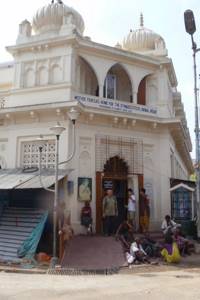
In the diaries of Mother Teresa there is a story about how one day she was going to Kalighat to visit her wards, and she met a man of a very respectable and at the same time gangster appearance.
One of those people who are said to have the entire criminal code on his forehead. In response to a request for help at home, he, openly mocking, said that he could only offer her a pack of cigarettes. To which Mother Teresa exclaimed: “How timely! We recently received a patient who was suffering without tobacco. And we didn’t know where to find the money to buy him a smoke.”
Was it promiscuity or good-naturedness? Hardly. Rather, the presumption of life over the idea, no matter how lofty the idea may seem.
In the opposition between “the life of another person or the purity of one’s own garments,” Mother Teresa always and unconditionally chose life.
Therefore, she, indeed, sometimes had to deal with rather dubious public, for example, with the same Haitian leaders. They offered help - and it responded, as it responded to everyone who, regardless of obvious or secret motives, was ready to do at least something to “one of the small forces.”
She understood perfectly well with whom she had to communicate, but she was convinced that vicious people needed mercy almost more than good ones.
Mother Teresa's diaries and letters destroyed the seductive and unhealthy illusion of cheerful charity. “If only you knew from what rubbish poetry grows, knowing no shame,” wrote Akhmatova. It turned out that charity sometimes also grows from “trash.”
Perhaps this has become the most accessible target for “whistleblowers.” However, revelations, including the acclaimed book and film by American journalist Christopher Hitchens, appeared from time to time even before the release of Mother Teresa’s private recordings.
They could be more or less justified, the sincerity of their authors could also vary from zero to ten, but I, the reader, always had the question: “Why all this?” To say once again that the universally adored saintly philanthropist is flawed? Yes, it’s true, and her private notes are the first evidence of this. To prove once again that everything in the world is done with dirty hands and there are no worthy ones?
This is a crafty game of bearishness, all the more crafty because it claims to know the truth. The remarkable linguist Mikhail Viktorovich Panov once said that the average person savors the unsightly details of the lives of great poets in order to console himself, they say, and they are no better. Behind the “sugar statue” you will not see the truth about a living person, but supposedly revealing slander clearly leads away from the truth. It's like Scylla and Charybdis, and the path of understanding is always between them.
Communicated, but didn't sell
As can be seen from letters and diaries, Mother Teresa was often extremely selective. She knew how to resolutely distance herself, especially when she saw that they were trying to “buy” her, for example, with fame, or use her name for purposes that, in her opinion, were unworthy. The only goal that justified for her both the publicity she so disliked and a variety of acquaintances was “for the sake of one of these little ones.”
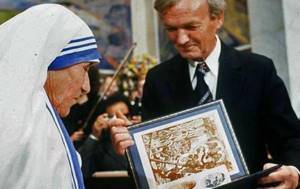
In her Nobel speech, she says that she accepts the prize only for the sake of the outcasts and those who are useless to anyone. During her last visit to the USA, at a meeting with major bankers and businessmen, she thanks them for their willingness to help - and immediately clarifies that it is not at all necessary to donate huge sums to the Missionaries of Charity: helping “her poor” (with this word she used not only the poor, but all the sick, abandoned, helpless and persecuted) begins with attention to elderly parents, to the beggar, in whom no one sees a person.
She reminds the bishops gathered for the pan-European conference that “it is easy to talk endlessly about poverty in other countries, but we often have no idea about the suffering, lonely people ... who live next door to us ... and we don’t even have time to to make them smile."
It seemed to the dictators that they were hiding behind the name of Mother Teresa, and she accepted money from them in the clear confidence that Providence could turn even an unkind gesture into good.
There was no God, there is no God and there never will be?
We, church people, often think that Providence acts in a “black and white” paradigm, but in an incomprehensible way for us it whitens what we disdain to touch. If you think about it, confirmation can be found even in your own life. In the late 90s, we needed to raise a significant amount for the treatment of a child we knew. We applied to various church organizations, but no matter where we went, we were always refused.
And suddenly a crazy thought came to me - to write to a friend who lived in America at that time. He was not even a man of atheistic, but radically anti-God views, very cynical and incredibly calculating. But it happens that out of powerlessness you take steps that are unreasonable at first glance. I closed my eyes and wrote to him.
Soon he replied: I, of course, can hang this request at my university, but only so that no one responds and you, obscurantists, are convinced that there is no God, has not existed and will not exist. “Okay,” I said.
A few days later I received a letter from a complete stranger asking me to forward medical documents. She was a student at the same university where my friend worked. Last summer she earned the amount we required and just at that time she was thinking about what to spend it on. We sent her the statements and paid for the transplant on time.
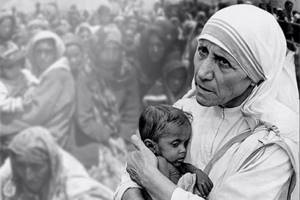
In my opinion, stories like these are parables of God's unpredictability and human ignorance. Apparently, Mother Teresa had great faith in both unpredictability and ignorance. She was not a moral omnivore; on the contrary, many consider her extremely rigid, but - here we again return to the main motive of all her actions -
“for the sake of one of these little ones,” she more than once sacrificed her own name when she accepted help from odious figures - and became “unshakable” even for some loved ones.
— Were there any cases when the powers that be did not give in?
- Repeatedly. And not only the strong, but also the pious, including those who accused her of moral promiscuity. Mother Teresa talks about this in a vague way, most often without naming names, and very sadly; again it didn’t work out, again it didn’t work out, again they drove me away.
In a letter to her confessor, she complains that they cannot raise funds to open a house where Indian girls, forced by poverty to sell themselves, could find shelter and learn crafts. A few years earlier, in her diary, she describes how she spent the whole day unsuccessfully searching for shelter for the first community of sisters: “Today I learned a good lesson - it turns out that it is often very difficult to be poor. When I was once again looking for a house for us - I walked until my arms and legs ached from fatigue - I suddenly realized that the soul and body of the poor were also groaning because they were constantly forced to look for a roof over their heads - food - at least some help... My God, grant me strength now - at this moment - to withstand what You are calling me to.”
Soon after opening the house in Kalighat, she received death threats because she had desecrated the sanctuary of the patroness of Calcutta with her sick, lepers and dying people. “In Kalighat,” she wrote to the Calcutta Archbishop, “there is trouble again - I was very rudely told that I should thank my God that I have not yet received a beating or a bullet in the forehead, because there is no other reward than death for those who works here, they don’t deserve it... Hard times are coming, please pray that we can pass the test of Mercy.”
A saint is an inconvenient person
— A distorted idea of holiness arises, first of all, in the church environment, from there it is transmitted to the secular one. Where do such distortions come from?
— I think they have an extensive root system. The first reason, in my opinion, is that over time the Church - both Western and Eastern - has moved away from the biblical concept of holiness. We often see in a saint “an excellent student of the Lord God,” however, in Scripture, a saint is, first of all, “separated,” someone else, in other words, who does not live like other people.
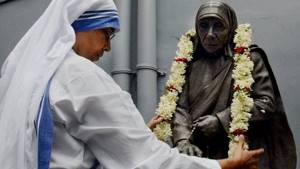
The history of the “holy people” begins with the fact that God takes them “as his inheritance,” separates them from other nations and commands them to live differently.
For example, your neighbors, as befits pagans, persecute foreigners, but you will receive the stranger, for “you too were slaves in the land of Egypt.” We are accustomed to perceiving the saint as a role model, but if he “shows” anything, it is not the behavioral example of “do to us as we do,” but the otherness, the otherworldliness of the Kingdom of God, which manifests itself differently in every life.
In the early stories about the saints, one could still recognize a “verbal icon”, in which the features of the Kingdom appeared through the image of a “visible person”, but over time, the hagiographic canon with a stable set of etiquette formulas ossified, and the life, according to D.S. Likhachev, becomes a “monumental form”, behind which it is increasingly difficult to feel a living, searching, suffering personality.
However, the point is not only in the texts themselves, but also in the fact that modern people, including church people, as a rule, are not taught to perceive them: from a “verbal icon” they expect a portrait resemblance and clear didactic instructions.
Another reason is due to the fact that in our everyday life (and church people are no exception here) the word “saint” is used in the meaning in which it, having undergone sentimentalist and romantic influences, was entrenched in Russian literature of the 19th century. Saint as “ideal”, “immaculate”, perfect in all respects.
Even my church-going students at the Public Orthodox University named after Fr. Alexandra I was defined as a saint as a “very good”, “sinless person”. But I don’t think that having met, for example, with Rev. Maximus the Confessor or with Saint Francis, they would agree to join these “good people”. Precisely because they are different.
As Clive Lewis rightly said, “Christians often think how much suffering the world causes to the saints; but saints also cause the world a lot of suffering.”
It is hardly worth “demanding” that a saint conform to our “hero image” or cultural expectations. This is often a very “inconvenient” person, who with all his undivided will responded to the call addressed to him, decided to “go to an unknown country,” and from his complex, contradictory life God creates something.
Honest but very tough
Mother Teresa was just such an “inconvenient” saint. Like every living person, she made many mistakes, and was ready to admit them.
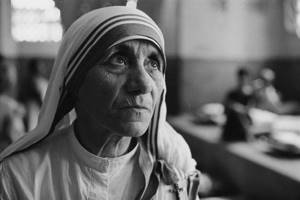
Sisters often suffered from Mother Teresa, and many who knew her talk about this. Many people were never able to forgive her, they left the congregation with grievances and then wrote accusatory texts.
I myself stumbled over this rigidity when translating the testimonies published in the final part of the book “Be My Light.”
One of the sisters said that she once came to M. Teresa in deep despondency, with a feeling of complete uselessness of all this fuss with the sick and of her own uselessness. This is an inevitable test in any serious business, when the time of gifts gives way to a time of hard work, and you begin to think: why all this?
Mother Teresa, by then already an abbess, listened to her sister and replied: “You should still smile at Jesus.”
I struggled with this fragment for several days, because I very vividly imagined myself in the place of a despondent sister and my reaction: slam the door and never set foot on these sisters again.
When a person is having a hard time, such “spiritual advice” seems not just Pharisaic excuses, but slander against God.
What helped me resolve this situation for myself and translate Mother Teresa’s words as she pronounced them was the simple, generally speaking, thought that she had said this to herself dozens of times, and in situations that were hard to even imagine. “If you knew what darkness is in my heart... - in those years when the world admired the cheerfulness of the “radiant mother,” she wrote to her confessor. “A smile is a huge cover behind which you can’t see how much pain I’m in.”
As far as one can judge from private notes, Mother Teresa was fully aware of her own harshness, and more than once reminded herself that she needed to be softer and more patient with her sisters.
Those who came to the congregation were made to understand from the very beginning that the missionary of mercy would need a lot of mental and physical strength; “outbursts of compassion” would not be enough.
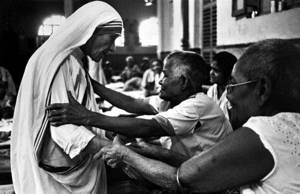
But the ruthless height of demands, as can be seen from the texts, was combined with Mother Teresa’s amazing sobriety. One of her Irish correspondents, a teacher who was eager to come to India, but realized that she was squeamish, and every time she had to overcome disgust in order to touch a festering wound, her mother very categorically refuses, and then, in her characteristic manner, offers another exit:
“You can get involved in our cause in other ways. For example, telling your students that poor people are people too. They need not only our alms, but our smile... You can take care of your parents, in a few years they will become just like our sick and lepers. And you can always help us with prayer.”
With the publication of Mother Teresa's diaries, the Catholic Church took a bold, even risky step. The world-famous philanthropist and saint appeared in her weakness and vulnerability.
This opened her up to the court - and the court did not hesitate. The judges, of course, will not change, but, on the other hand, the controversy surrounding the personality of Mother Teresa, as well as around the Parisian new martyrs (Mother Maria (Skobtsova), Father Dimitri Klepinin, Ilya Fondaminsky, the son of Mother Maria Yuri Skobtsov, canonized by the Patriarchate of Constantinople), and other controversial saints of the 20th century, leave hope that sooner or later the Church and the world will be able to break through the rhetoric of judgment and justification to the difficult truth that is revealed by saints so different from each other and from our ideas about them.
Stepan Abrikosov
Source: Mercy.ru









